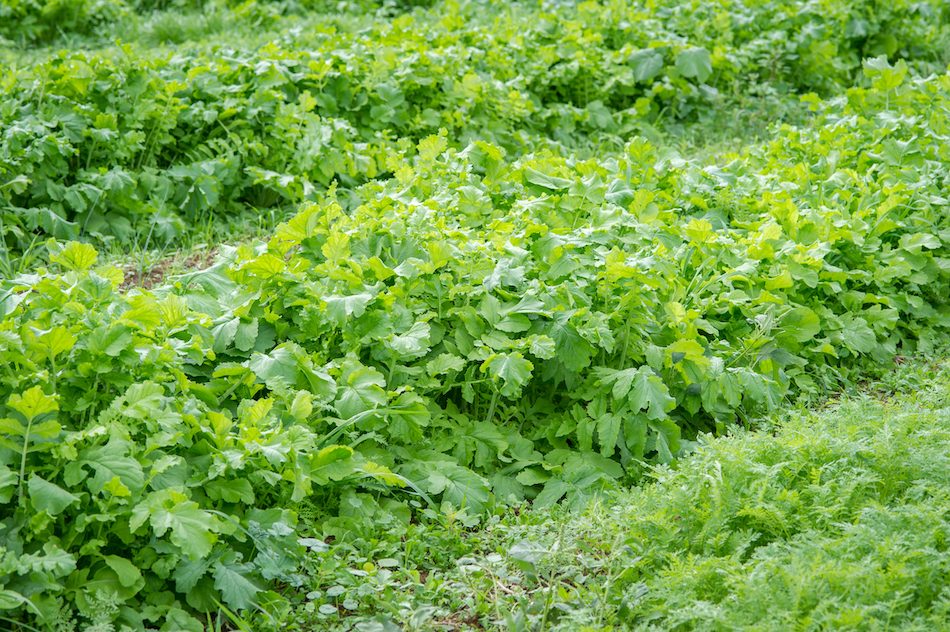Brassicas feature in most polycrop seed mixes on the market, but feeding cattle on those mixes may require some extra consideration.
Jillian Bainard, of AAFC Swift Current, noted that cattle were less likely to graze brassicas during her ongoing study into grazing intercrops. The study hosted plots at Manitoba Beef and Forage Initiatives in Manitoba, AAFC in Swift Current and two western Canadian cattle operations in Kelliher, Sask., and Outlook, Sask.
Why it matters: Most pre-made cover crop mixes will have something like tillage radish to break up compaction or other brassicas to boost biomass, but producers interested in putting that biomass through a cow will have to make sure the herd isn’t going to turn up their nose.
The researcher has been testing the impact of grazing on intercrops, as well as species diversity. Bainard is comparing a simple oat-pea mix with a complex intercrop of oats, peas, barley, hairy vetch, tillage radish, Winifred brassica, millet and phacelia. The more complex mix purposefully blended grasses with brassicas, legumes, and added flowering plants like phacelia for the sake of pollinators.
The herd Bainard managed at Swift Current left more biomass behind and were unwilling to graze brassicas in the complex mix, she noted. That unwillingness persisted even when she pushed the paddock. The herd was composed of yearlings, however, she added, and therefore may have been more likely to be picky grazers. The study comprised of eight yearling steers rotated in pastures less than an acre and a half large.
Picky grazers will be a herd-to-herd issue, she noted, and not all farms will experience the same challenge.
Clayton Robins, who farms near Rivers, and regularly speaks on his annual grazing system, says he has not seen similar herd preference issues on his farm, although he does not discount the idea that a farmer trying out intercrop grazing might run into that hurdle.
“It’s clear that herds are very preferential for a lot of different species, so one producer’s cattle might eat a certain plant and the guy across the fence, their cattle might not. It’s all part of the learning process in terms of what species are going to work in the grazing system you’re trying to design at home,” he said.
A producer may miss out on a critical nutritional component if they design a mix for a specific nutrition need, but then cattle refuse to graze evenly, he added.
He advises producers to keep a herd’s familiarity with a crop in mind when picking an annual grazing mix.
He also echoed Bainard’s thoughts on yearlings.
“From a planning perspective at a producer level, if a calf gets a chance to graze a cover crop mix with their mother, there’s a much stronger opportunity for them to go back and recognize and graze those plants the next year as a yearling,” he said.
Edward Hummel a cow-calf producer near Ashern, says he has had his own issues with cover cropped brassicas slated for cattle feed.
His family recently relocated from Saskatchewan, but has historically used polycrops on their cow-calf operation.
The presence of brassicas makes those crops almost impossible to dry down for baling, he noted, making silage a key option if that polycrop is to be harvested for feed.
“Before you seed your crop, you kind of want to know your end result, whether you’re going to silage the crop or cut and bale the crop or graze the crop and that will determine what species you’re looking to use,” he said.
Pre-made blends are also not always the best suited for a producer’s area, he noted, and urged producers to carefully choose species that will grow in their area and, if new to polycropping, start with simple mixes that cattle are more likely to graze without prodding.
His own blends tend to feature at least four species, sometimes including a brassica and usually featuring both a cool- and warm-season grass to hedge his bets on weather, he said.
Despite the challenges, Bainard said there are still good reasons to consider brassicas in the cover crop or intercrop mix.
“It does have some of those nutritional benefits as being very digestible,” she said. “It (has) very big productivity, so large biomass, but, on the flip side, I’m really interested in it for some of its weed control.”
The addition of brassicas gives “another aspect of diversity” to a mix, she added. Biodiversity is an important goal of producers who ascribe to regenerative agriculture or hope to use those differing root profiles to improve the soil.
Tillage radish, for example, is one of the most common compaction busters cited when producers begin experimenting with polycrops.
Those taprooted brassicas may not be the only option for those benefits, however, some experts have argued, while the reliance on brassicas like tillage radish might become a rotational problem.
This summer, provincial soil specialist Marla Riekman expressed some misgiving of tillage radish in a cover crop, citing potential pest bridges between the brassica and canola. Clubroot, for example, has been a growing concern in Manitoba with seven municipalities noting high spore counts or symptoms as of last year. Adding more brassica in a cover crop might fail to break the pest cycle critical in keeping those pests and pathogens at bay, Riekman noted, adding that there are non-brassica species with taproots that could offer similar soil benefits.
Those rotational concerns are still valid for the cattle producer, particularly mixed producers with both annual crops and livestock.
“I think if someone is doing a rotation that includes brassicas like canola, you would really want to watch that your rotation didn’t happen too often where you’re getting the radishes or the turnips or those things, because I think some of them could result in those pathogens staying there as opposed to breaking up the rotation as you might want to,” Bainard said.





Post a comment
Report Abusive Comment